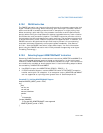
8-62 Vol. 3
MULTIPLE-PROCESSOR MANAGEMENT
using OS specific APIs.
// Allocate per processor arrays to store the Package_ID, Core_ID and SMT_ID for every started
// processor.
ThreadAffinityMask = 1;
ProcessorNum = 0;
while (ThreadAffinityMask != 0 && ThreadAffinityMask <= SystemAffinity) {
// Check to make sure we can utilize this processor first.
if (ThreadAffinityMask & SystemAffinity){
Set thread to run on the processor specified in ThreadAffinityMask
Wait if necessary and ensure thread is running on specified processor
APIC_ID = GetAPIC_ID(); // 32 bit ID in Example 8-19 or 8-bit ID in Example
8-20
Extract the Package_ID, Core_ID and SMT_ID as explained in three level extraction
algorithm of Example 8-21
PackageID[ProcessorNUM] = PACKAGE_ID;
CoreID[ProcessorNum] = CORE_ID;
SmtID[ProcessorNum] = SMT_ID;
ProcessorNum++;
}
ThreadAffinityMask <<= 1;
}
NumStartedLPs = ProcessorNum;
b) Using the list of PACKAGE_ID to count the number of physical packages in a MP system and
construct, for each package, a multi-bit mask corresponding to those logical processors residing in
the same package.
// Compute the number of packages by counting the number of processors
// with unique PACKAGE_IDs in the PackageID array.
// Compute the mask of processors in each package.
PackageIDBucket is an array of unique PACKAGE_ID values. Allocate an array of
NumStartedLPs count of entries in this array.
PackageProcessorMask is a corresponding array of the bit mask of processors belonging to
the same package, these are processors with the same PACKAGE_ID
The algorithm below assumes there is symmetry across package boundary if more than
one socket is populated in an MP system.
// Bucket Package IDs and compute processor mask for every package.
PackageNum = 1;
PackageIDBucket[0] = PackageID[0];
ProcessorMask = 1;


















